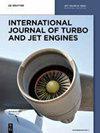Integrated modeling and coupling characteristics analysis of helicopter/engine/infrared suppressor
IF 0.9
4区 工程技术
Q4 ENGINEERING, AEROSPACE
引用次数: 0
Abstract
Abstract In order to explore the influence of the infrared stealth technology on the performance of the integrated helicopter/engine system, an integrated modeling method of helicopter/engine/infrared suppressor is proposed. Firstly, based on the power calculation model of the helicopter, combined with the high-precision turboshaft engine component-level model, an integrated simulation platform is built, which takes into account the nonlinear characteristics. Then, the aerodynamic characteristics of infrared suppressors under different engine operation states are studied by CFD numerical computation method, and the infrared radiation characteristics are obtained through combining the positive and negative ray tracing method and narrow band model method. Ultimately, the utilization of the power turbine outlet stagnation pressure is employed as the pivotal interface linking the turboshaft engine and the infrared suppressor in order to formulate an integrated model encompassing the helicopter, engine, and infrared suppressor subsystems. The simulation results demonstrate that compared with the conventional exhaust system, the application of the infrared suppressor greatly enhances the stealth performance of the helicopter, but also results in the unexpected decrease in engine output power. Moreover, the specific fuel consumption of the turboshaft engine increase and the compressor surge margin decreases in case of the consistent flight condition.直升机/发动机/红外抑制器集成建模与耦合特性分析
摘要为了探索红外隐身技术对直升机/发动机集成系统性能的影响,提出了一种直升机/发动机/红外抑制器集成建模方法。首先,在直升机动力计算模型的基础上,结合高精度涡轴发动机部件级模型,建立了考虑非线性特性的综合仿真平台;然后,采用CFD数值计算方法研究了红外消声器在发动机不同工作状态下的气动特性,并结合正负射线追迹法和窄带模型法得到了红外辐射特性。最后,利用动力涡轮出口滞止压力作为连接涡轴发动机和红外抑制器的关键接口,建立了包含直升机、发动机和红外抑制器子系统的集成模型。仿真结果表明,与传统排气系统相比,红外抑制器的应用大大提高了直升机的隐身性能,但也导致了发动机输出功率的意外下降。在相同的飞行条件下,涡轮轴发动机的比油耗增加,压气机喘振裕度减小。
本文章由计算机程序翻译,如有差异,请以英文原文为准。
求助全文
约1分钟内获得全文
求助全文
来源期刊

International Journal of Turbo & Jet-Engines
工程技术-工程:宇航
CiteScore
1.90
自引率
11.10%
发文量
36
审稿时长
6 months
期刊介绍:
The Main aim and scope of this Journal is to help improve each separate components R&D and superimpose separated results to get integrated systems by striving to reach the overall advanced design and benefits by integrating: (a) Physics, Aero, and Stealth Thermodynamics in simulations by flying unmanned or manned prototypes supported by integrated Computer Simulations based on: (b) Component R&D of: (i) Turbo and Jet-Engines, (ii) Airframe, (iii) Helmet-Aiming-Systems and Ammunition based on: (c) Anticipated New Programs Missions based on (d) IMPROVED RELIABILITY, DURABILITY, ECONOMICS, TACTICS, STRATEGIES and EDUCATION in both the civil and military domains of Turbo and Jet Engines.
The International Journal of Turbo & Jet Engines is devoted to cutting edge research in theory and design of propagation of jet aircraft. It serves as an international publication organ for new ideas, insights and results from industry and academic research on thermodynamics, combustion, behavior of related materials at high temperatures, turbine and engine design, thrust vectoring and flight control as well as energy and environmental issues.
 求助内容:
求助内容: 应助结果提醒方式:
应助结果提醒方式:


